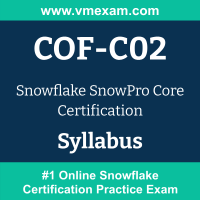 The Snowflake COF-C02 exam preparation guide is designed to provide candidates with necessary information about the SnowPro Core Certification exam. It includes exam summary, sample questions, practice test, objectives and ways to interpret the exam objectives to enable candidates to assess the types of questions-answers that may be asked during the Snowflake Certified SnowPro Core Certification exam.
The Snowflake COF-C02 exam preparation guide is designed to provide candidates with necessary information about the SnowPro Core Certification exam. It includes exam summary, sample questions, practice test, objectives and ways to interpret the exam objectives to enable candidates to assess the types of questions-answers that may be asked during the Snowflake Certified SnowPro Core Certification exam.
It is recommended for all the candidates to refer the COF-C02 objectives and sample questions provided in this preparation guide. The Snowflake SnowPro Core Certification is mainly targeted to the candidates who want to build their career in Associate and Core domain and demonstrate their expertise. We suggest you to use practice exam listed in this cert guide to get used to with exam environment and identify the knowledge areas where you need more work prior to taking the actual Snowflake SnowPro Core Certification exam.
Snowflake COF-C02 Exam Summary:
|
Exam Name
|
Snowflake SnowPro Core Certification |
| Exam Code | COF-C02 |
| Exam Price | $175 USD |
| Duration | 115 minutes |
| Number of Questions | 100 |
| Passing Score | 750 + Scaled Scoring from 0 - 1000 |
| Recommended Training / Books |
Snowflake Fundamentals SnowPro Core Certification Preparation Course SnowPro Core Study Guide Snowflake Hands on Essentials & Level Up Series Snowflake in 20 Minutes |
| Schedule Exam | PEARSON VUE |
| Sample Questions | Snowflake COF-C02 Sample Questions |
| Recommended Practice | Snowflake Certified SnowPro Core Certification Practice Test |
Snowflake SnowPro Core Certification Syllabus:
| Section | Objectives | Weight |
|---|---|---|
| Snowflake AI Data Cloud Features and Architecture |
- Outline key features of the Snowflake AI Data Cloud.
- Outline key Snowflake tools and user interfaces.
- Outline Snowflake’s catalog and objects.
- Outline Snowflake storage concepts.
|
24% |
| Account Access and Security |
- Outline security principles.
- Define the entities and roles that are used in Snowflake.
- Outline data governance capabilities in Snowflake.
|
18% |
| Performance and Cost Optimization Concepts |
- Explain the use of the Query Profile.
- Explain virtual warehouse configurations.
- Outline virtual warehouse performance tools.
- Optimize query performance.
- Describe cost optimization concepts and best practices in Snowflake.
|
16% |
| Data Loading and Unloading |
- Define concepts and best practices that should be considered when loading data.
- Outline different commands used to load data and when they should be used.
- Define concepts and best practices that should be considered when unloading data.
- Outline the different commands used to unload data and when they should be used.
|
12% |
| Data Transformations |
- Explain how to work with structured data.
- Explain how to work with semi-structured data.
- Explain how to work with unstructured data.
|
18% |
| Data Protection and Data Sharing |
- Outline Continuous Data Protection with Snowflake.
- Outline Snowflake data sharing capabilities.
|
12% |
